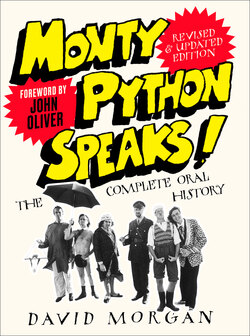Читать книгу Monty Python Speaks! Revised and Updated Edition - David Morgan - Страница 13
HAVE WE SHOWN ’EM WE GOT TEETH?
ОглавлениеThe lone American of Python – a native of Minnesota and a product of Los Angeles – Terry Gilliam fled the land of his birth in the late Sixties by turning the advice of Horace Greeley on its end and heading east, first to New York, then London. He worked in magazines as an illustrator and designer, most notably for Help!, published by the creator of Mad magazine, Harvey Kurtzman.
TERRY GILLIAM: I always drew when I was a kid. I did cartoons because they were the most entertaining. It’s easiest to impress people if you draw a funny picture, and I think that was a sort of passport through much of my early life. The only art training I had was in college, where I majored in political science. I took several art courses, drawing classes, and sculpture classes. I’d never taken oil painting, any of those forms of art, and I was always criticized because I kept doing cartoons instead of more serious painting.
My training has actually been fairly sloppy and I’ve been learning about art in retrospect. In college I didn’t take things like art history courses. I didn’t like the professor and it was a terribly boring course, so I didn’t really know that much. But I’ve always just kept my eyes open, and things that I like I am influenced by.
Once I had my little Bolex camera, every Saturday with a three-minute roll of film we’d run out and invent a movie, depending upon what the weather was. I remember doing animation that way as well; we would go around the dustbins and get old bits of film and then we’d scratch on them, each frame, make little animated sequences; it was pathetic! But you were kind of learning something in the course of all this – anger, I think, is what I was learning, hatred for society, and wealth, and powerful people who I’ve never been able to deal with subsequently!
I spent about a year and a half in advertising in Los Angeles. My illustrating days were becoming less and less remunerative, and Joel Siegel (now the famous television critic) was an old friend, in fact the very first cartoon I ever had published was an idea by him. He was working at an ad agency and got me in because I had long hair – the agency needed a longhair in the place – so I became an art director and copywriter. The last job we had there Joel and I were doing advertisements for Universal Pictures, and we hated the job. Richard Widmark did a film called Madigan, and the kinds of things we were throwing back at Universal were: ‘Once he was happy, but now he’s MADIGAN!’
CLEESE: I’d got to know Terry Gilliam in New York a little bit.5 He turned up in England out of the blue – must have been 1966 – and I remember having lunch with him when I was doing At Last the 1948 Show. I introduced him to one or two people, including Humphrey Barclay, who was producing Do Not Adjust Your Set. So Humphrey used him on a London Weekend Television show called We Have Ways of Making You Laugh. Terry used to do little sketches, caricatures of guests appearing on the show.
How did you start with animation in England?
GILLIAM: That was just a fluke, really. When I was in London, still drawing these fucking cartoons, I was on a show doing caricatures of the guests, and they had some material they didn’t know how to present. I remembered seeing somewhere years earlier, projected on a sheet in somebody’s flat, a Stan VanDerBeek cartoon. It was the first time I’d ever seen cutout animation, and it was Richard Nixon photographed with a foot in his mouth, trying to get it out. I thought it was outrageously funny. So on the show I said, ‘Why don’t I make an animated film?’ And they let me. And overnight I was an animator.
I had two weeks to do it in, and four hundred pounds. The only way I could do it in that time was using cutouts. I just did these silly things with these cutouts and nobody had ever seen that before on British television. And the result was instantaneous; within a week I had all these offers to do all this other stuff. That’s the power of that going out there and millions of people seeing your stuff.
